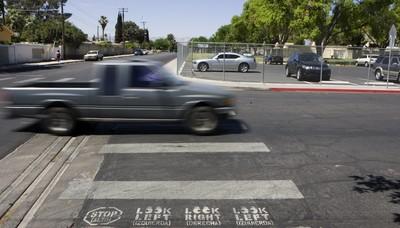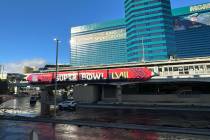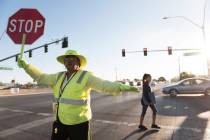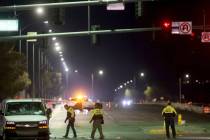Stencil foe looks left, right for rules

It’s just a spray-painted stencil. You can’t trip over it. Cars won’t crash into ’em. The world won’t end as a result of its innocuous message:
Stop. Look left. Look right. Look left.
So, when the child safety group Look Out Kids About went to the Las Vegas Valley’s road poobahs about putting those stencils at the foot of crosswalks near schools — out of the sight lines of passing drivers, as a timely reminder to kids to take care — they figured it was no big deal.
"It just reminds them to stop, look and listen," said Bill Niver, a safety group member.
No problem, said officials at the city of Las Vegas.
No way, said authorities with Clark County.
While the city has allowed the stencils to be placed in crosswalks around 10 elementary schools, the county is balking at allowing any such thing.
"Something about code, consistency," Niver said. "Something like that."
That’s nothing new. Whether it’s stenciling or putting in stoplights or posting school speed zones, the county has often cited value laws and technical guidelines in slowing or denying requests. Meanwhile, the city has taken a more practical approach: If it makes sense, let’s try it.
"If there’s something that might help children look out for traffic, we think it might be a little plus," city traffic engineer O.C. White said. "We didn’t have a problem with them doing that."
The stencils weren’t created in a vacuum. White is a member of Look Out Kids About, as are officials from the Clark County School District, AAA Nevada and the Nevada PTA. The group also consulted Las Vegas police.
The stencils are modeled after stencils found in touristy parts of London (where we Yanks aren’t used to their habit of driving on the left-hand side of the road). And the group is arranging for volunteer stencilers and donated paint.
Still, the stencils didn’t make it past Herb Arnold, the county’s chief traffic engineer, said Scott Konnath, secretary for Look Out Kids About and safety committee chairman for the Nevada PTA.
"He goes by the letter of the law," Konnath said. "He’ll go right by the book."
That book is the Manual on Uniform Traffic Control Devices, a federal guide that spells out how, when and why traffic signs, lights and stripes should be used, in hopes of creating consistency. The book is why stop signs look the same in Summerlin as in Scranton. Apparently, MUTCD doesn’t specifically spell out stenciling rules.
After I called the county and asked to talk to Arnold or whoever else wanted to chat, I got this statement via e-mail:
"Up to this point in time, the county has not authorized the use of these ‘stencil’ markings as their use would require the county to request Federal Highway Administration authorization to experiment with such markings in order to determine the effectiveness of the stencils."
See what Konnath means?
"Should the city’s experimentation lead to this ‘stenciling’ idea being accepted as a tool within the Manual on Uniform Traffic Control Devices, the county is more than willing to explore funding and maintenance costs/options," the e-mail stated. "At this time, the county has not heard of any results from the city’s experiment."
I’ll let you in on my own scientific finding: It’s just a stencil, not an atomic bomb. No one is pretending that the stencils carry any legal weight. It’s just simple advice for kids, put in a place that can’t distract drivers.
"It’s kind of like general information. It’s not a traffic control device," White said. "It’s just trying to remind kids to stop, look left, look right."
OK, so MUTCD doesn’t specifically allow stenciling. Still, is there anything in MUTCD or state law that would prohibit stenciling?
"Not that I know of," White said.
So, if the city and county are essentially reading from the same playbooks, why are there such different conclusions? Why wouldn’t the county allow this?
"I hate to tell you. I have no idea," White said. "I don’t know what their procedures are, their policies are, as far as what they allow and don’t allow."
Not long ago, County Commissioner Lynette Boggs McDonald railed against the county’s approach. But then we couldn’t figure out where she lived, and soon she vanished from public office. Since then, I’m not aware of any other commissioners stepping forward to question why the county does what it does, or doesn’t do.
Niver said the situation would be easy to resolve.
"All somebody has to say is, ‘Go for it.’ It’s a win-win for everybody," he said. "It all comes down to watching your kids. We’d rather have them come home at the end of the day than end up in the hospital."
Konnath is hopeful the city’s example will eventually ease the county’s concerns, and allow consistency to fall on the side of common sense.
"Inside the valley, traffic controls should be standard," he said. "They should be doing the same thing."
In its e-mail, the county said stencils have "both pros and cons associated with their use. A couple of the county’s concern would be: do such markings provide any benefit for the associated costs to install and maintain; and, is the message clearly understood."
Sure. It may not work. Kids can ignore ’em. Then again, they may not.
It’s not costing taxpayers anything. No crime is being committed. We’re not talking about deconstructing civilization as we know it. We’re talking about stencils.
What can it possibly hurt to try?
If you have a question, tip or tirade, call the Road Warrior at 387-2904, or e-mail him at roadwarrior@reviewjournal.com or OSofradzija@reviewjournal.com. Please include your phone number.
ROAD WARRIORMORE COLUMNSDiscuss this column in the eForums!
Starting at 2:30 a.m. Monday, various overnight and morning lane restrictions can be expected at the intersection of Las Vegas Boulevard and Flamingo Road to allow pavement replacement work. All travel lanes are expected to be reopened by 11 a.m. daily. The work is expected to last about two weeks. Drivers can expect delays and should use alternate routes, if possible. Various overnight lane closures can be expected on U.S. Highway 95 between Las Vegas Boulevard and the Las Vegas Beltway interchange in Henderson between 9 p.m. and 5 a.m., Sunday nights through Friday mornings, to allow road work. Drivers should follow lane shifts as directed. The southbound U.S. Highway 95 ramp to eastbound Lake Mead Parkway in Henderson will be closed nightly from 9 p.m. to 5 a.m., tonight through Tuesday morning. Drivers should detour to the Auto Show Mall Drive exit ramp. The southbound U.S. Highway 95 onramp and offramp at Rancho Drive near downtown Las Vegas and the northbound U.S. Highway 95 onramp at Rancho Drive will continue to be closed through the end of April to allow interchange reconstruction work. Drivers should use alternate routes. The southbound U.S. Highway 95 offramp to Decatur Boulevard is closed through the end of April. Drivers can detour to the Valley View Boulevard exit. Drivers can expect lane restrictions on northbound and southbound Interstate 15 between the California-Nevada state line and the Cajon Pass near Devore, Calif., in San Bernardino County, Calif. Drivers should expect delays and watch for updates on specific closures. To sign up for e-mail alerts on I-15 road work in California or for more project information, go online to www.caltrans8.info. For phone updates on Southern California road work, call (916) 445-7623 or (909) 383-7960.


















